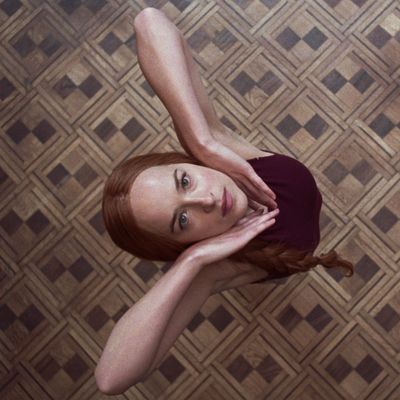
Luca Guadagnino’s Suspiria, which expands its theatrical run this weekend, may forego the lush color palette that Dario Argento’s original is famous for, but it still makes a mighty visual impact. A big reason why: the film’s intricately staged dance sequences, which are woven together with scenes of extravagant violence. In the new Suspiria, dance is an act of both life and death. It lifts the members of the Helena Markos Dance Company into a state of higher consciousness, but by channeling the power of the witches running it, can also be used as a weapon to murder, maim, and summon death itself.
There are three key performances that chart the path of Susie Bannion (Dakota Johnson) as Madame Blanc (Tilda Swinton) grooms her to fulfill the coven’s long-simmering plans to save its deteriorating leader, Helena Markos (also Tilda Swinton in heavy prosthetics!). The dances themselves are captivating, but when spliced together with scenes of ritual torture they make for a discomfiting codependency between grace and brutality. To more fully understand how that tension came to life, Vulture spoke with Belgian choreographer Damien Jalet about Suspiria’s featured dance pieces.
Olga’s Last Dance
Earlier this year, sneak-peek footage of Suspiria was shared at the closed industry event CinemaCon, and reports came rolling out of a woman being hideously contorted into “a mess of broken bones, urine, spittle, and blood.” When the film’s teaser finally arrived months later, we saw a brief glimpse of a woman pressed against a mirrored wall with her jaw being snapped out of place. That woman was Elena Fokina in the role of Olga, a young dancer trying to flee the Academy after coming to suspect that its matrons are up to no good, and the extreme pain she endures comes courtesy of an oblivious Susie, who thinks she is auditioning for solo part, but is actually channeling the anger of the witches and punishing the obstreperous Olga.
“When I read this scene I said, ‘Oh, my god. This could be ridiculous if it’s not well done,’” Jalet said of the film’s first big sequence, which must establish dance as a driving plot element, connect the protagonist to the power of the coven, and showcase the thematic tension between life and death that dance creates in the world. “The script was describing something a bit more balletic with lots of kicks and high legs, but I was more interested to develop something more visceral, more internal, angular, with really sharp, clear direction that is coming from Susie.”
Jalet started by working together with Guadagnino and Fokina to map out Olga’s lines on the set where her part of the scene would take place. The character would be tossed about the room, but Jalet said it took “surgical precision” to make sure her movements could be synced up with Johnson’s in the editing room, all while taking into account the most effective angles for filming and the needs of the visual effects team, who would be outfitting Fokina with a graduating series of prosthetics to make her more mangled as the dance progressed. Oh and also, it had to look entirely reactive and spontaneous instead of “academic” or “too square.”
“With Elena we really worked on trying to generate body movement that seemed to be coming from an external, invisible force, something that she feels pushed, pulled, twisted, that makes her jump,” Jalet explained, adding that they wanted to rely on Fokina’s body as much as possible in place of digital effects. “We had to be very technical in the sense that the first thing that would get affected was the ribs and the throat and the arms then the legs. Elena is such a strong dancer and performer that she could really create all the violence within herself.”
Volk
In Suspiria, Volk is a dance created at the Academy that featured Blanc in the original role of the protagonist, the part Susie was auditioning for when she turned Olga into a human pretzel earlier in the film. And it’s actually based off a performance Jalet choreographed in 2013, called Les Médusés, that was staged at the Louvre. The themes Jalet built into that performance just happened to overlap uncannily with those of Suspiria’s central dance piece, so he modified it first for Olga’s death scene, when it would be a solo for Susie, and then again for the whole group during the recital. The original rope costumes, which were meant to convey a sense of being bound or tied up, were even reimagined for the film and changed from white to red.
“It was inspired by the sculptures in the Louvre museum where those nymphs seem to be under a spell,” said Jalet. “It’s all inspired by the myth of Medusa, to literally transform you into stone, to be stupefied, to be bewitched in a way. It’s really also interesting, because Medusa is one of the three Gorgons, and in Suspiria there is the Three Mothers. So, there was also a metaphor. All these female sculptures, a room full of women and female energy, but actually it has been sculpted by men. As a male choreographer, I wanted them to feel like they rebel against the curse of a certain female representation, and then it fit for me with the whole story line. It’s a dance of resistance, trying to break something, and the original trio was really trying to break a spell.”
The Les Médusés choreography was for meant for three women and had no featured soloist, meaning it had to be scaled up to 12 dancers for Volk with a protagonist part built in for Susie. Jalet modified the movements with the help of another dancer in Suspiria. He incorporated the image of the pentagram — without being too heavy-handed about it — via the design visible on the floor during the recital. (It also echoes the line drawing we see briefly in Patricia’s journal.) And while it was originally meant to appear as projected light, Jalet insisted it be literally laid out in silver tape. He wanted to make sure the dance was heavily informed by the number five and geometric patterns, connecting it to pagan iconography, and the visible floor design could serve the dual purpose of evoking a gateway to something being accessed by the witches and dancers, as well as a spider’s web trapping the performers in the influence of Markos. According to Jalet, Thom Yorke got hung up for six months on the score for the Volk scene while trying to effectively connect it to the dance movements, since the choreography had been designed to separate music.
The Black Sabbath
The organized chaos of the Black Sabbath is both an extension of and a reaction to the iterations of Volk. The more refined and exacting aspects of the earlier dances give way to something restless and raw. The dancers previously bound by ropes are now naked and wildly free of their bindings. The ever-present sound of breathing — which actually served as a substitute for percussion during Volk — reaches a frantic crescendo.
“A lot of the movements, I tried to make them come from the thoracic cage and also the lungs,” Jalet explained, extending the presence of the Mother of Sighs through all his work. “It’s already in the audition of Susie. It’s there during Olga’s scene, and then in Volk it’s very present, and in the Sabbath there’s this explosion of breathing that was very literally all coming from opening and closing the lungs.”
The Sabbath is also the culmination of Susie’s battle with gravity. She is scolded by Blanc at one point for her resistance to leaving the floor, because the pull of Markos is drawing her down to the Mutterhaus chamber under the Academy. That pull eventually leads Susie to the Room of the Feasts for the Black Sabbath. To create something more tribal than the earlier numbers, Jalet took inspiration from both an Indonesian dance done only by women on their knees that involves rapid hand movements, and from another show he previously choreographed, called Vessel.
“They are entranced but they are not conscious of what they are doing,” said Jalet. “In Vessel, they created these geometric forms just using their hair and the naked body to generate a totem or something. At one point the dancers become furniture in a way. With Luca we wanted to go from something pretty technical, mathematical, with a certain sense of elegance, to something where the body becomes wilder and more and more distorted — to work with these physical sculptures where the dancers become a decoration.” One of those decorations is a human pyramid that unfolds startlingly at the beginning of the ritual.
Given the setting, manufacturing a sense of madness wasn’t hard. The Sabbath was one of the last scenes they shot after months of production. It was December in the mountains. Everyone was freezing, and Jalet had to choreograph for about 40 different performers from different backgrounds and skill levels. One of the dancers nearly fainted because of the intensity of the movements, and it took a week just to film this one scene that weighs in at almost 15 minutes. But with bodies being disemboweled, heads exploding, and almost everyone in constant motion, each person’s path had to be meticulously laid out — which included making room for death incarnate as it passed through the room — to maintain purpose in the ritual.
“It was really wild,” Jalet said. “With all the organs and working with all this fake blood and all this hair everywhere, it was like this for a few days. Also, we were heating each other with a gas heater, so the air was really dry, and the dancers, because they were naked, wanted to have the smallest crew possible. It was a tense moment.”


